- genevb's home page
- Posts
- 2025
- 2024
- 2023
- 2022
- September (1)
- 2021
- 2020
- 2019
- December (1)
- October (4)
- September (2)
- August (6)
- July (1)
- June (2)
- May (4)
- April (2)
- March (3)
- February (3)
- 2018
- 2017
- December (1)
- October (3)
- September (1)
- August (1)
- July (2)
- June (2)
- April (2)
- March (2)
- February (1)
- 2016
- November (2)
- September (1)
- August (2)
- July (1)
- June (2)
- May (2)
- April (1)
- March (5)
- February (2)
- January (1)
- 2015
- December (1)
- October (1)
- September (2)
- June (1)
- May (2)
- April (2)
- March (3)
- February (1)
- January (3)
- 2014
- December (2)
- October (2)
- September (2)
- August (3)
- July (2)
- June (2)
- May (2)
- April (9)
- March (2)
- February (2)
- January (1)
- 2013
- December (5)
- October (3)
- September (3)
- August (1)
- July (1)
- May (4)
- April (4)
- March (7)
- February (1)
- January (2)
- 2012
- December (2)
- November (6)
- October (2)
- September (3)
- August (7)
- July (2)
- June (1)
- May (3)
- April (1)
- March (2)
- February (1)
- 2011
- November (1)
- October (1)
- September (4)
- August (2)
- July (4)
- June (3)
- May (4)
- April (9)
- March (5)
- February (6)
- January (3)
- 2010
- December (3)
- November (6)
- October (3)
- September (1)
- August (5)
- July (1)
- June (4)
- May (1)
- April (2)
- March (2)
- February (4)
- January (2)
- 2009
- November (1)
- October (2)
- September (6)
- August (4)
- July (4)
- June (3)
- May (5)
- April (5)
- March (3)
- February (1)
- 2008
- 2005
- October (1)
- My blog
- Post new blog entry
- All blogs
Run 9 TPC field cage currents
Run 9 saw a continuation of the partial resistor short on OFC west which was seen in previous years, plus a new "full" resistor short on OFC west. These can be seen from these 4 plots of currents versus day number, with east/west as left/right and outer/inner as top/bottom:
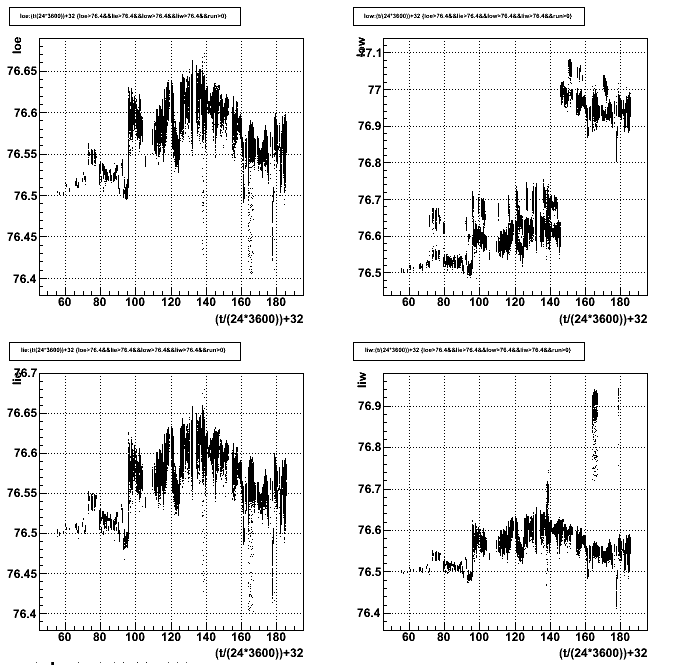
(Please open the image in a new tab or window for a larger version.)
A few things of note:
- All currents show a floating, but common baseline
- OFCW shows an intermittent partial short
- OFCW shows a full short around day 146
- IFCW shows a partial short on day 138, and a full short on days 164-166
- There appears to be noise of some sort on all channels concurrent with the shorts seen in the IFCW
This brings up some questions:
- Where are the shorts in the OFCW?
- How much missing resistance are the shorts in the OFCW?
- What channel do I use as a baseline correction to detect when intermittent shorts are occurring?
- Are the shorts in the IFCW real?
Question 1 has been answered by myself (I found the partial short to be at ring 80.5) and Na Li (who recently found that using ring 170.5 does well to remove the distortions). However, I have found something which may be more accurate than Na's work, and I will come back to this later.
To answer Question 2, I looked at the currents in the OFCW minus the currents in the OFCE, which may introduce some noise, but the peaks should serve as useful measures. From TPC documentation, the full resistor chain is 364.44 MOhms, so the missing resistance can be calculated by:
R_missing = R_full * (1 - (I_reference / I_measured)) = 364.44 MOhms * (1 - (I_OFCE / I _OFCW))
Here I fit the peaks for the full short and find that they are at 1.811 when the full short is there, and 0.014 when it is not. So the difference is 1.797, or pretty close to 1.8 MOhms (oddly less than the expected 2.0 MOhms for a full short; I'll come back to this point):
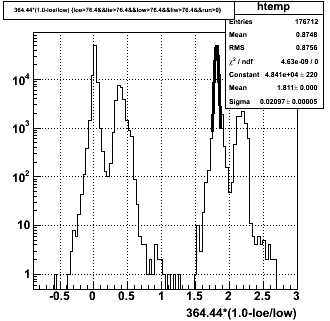

Next, the partial short can be found more readily by subtracting 1.797 MOhms for times after the full short appears (on May 24th, 2009), giving:
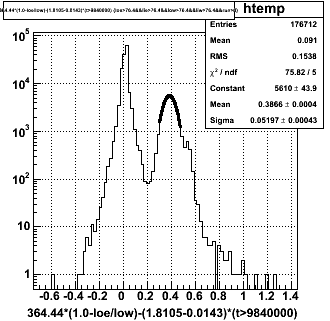
This implies the partial short is 0.3866 - 0.0143 = 0.3723 MOhms. In the past I have calibrated this to 0.345 MOhms, so I will leave it at 0.345 since this is within 0.03 MOhms and likely to be accurate enough for our needs (probably to within OFC West possible distortion on the last padrow).
Question 3 isn't so simple. In previous years, I have used IFCW. But this is clearly not usable with the observed shorting there. However, are the O/IFCE options any better? On the days when there is noise, it appears on all the channels. Here I plot OFCW minus OFCE versus time spanning the noise period on day 138 (left uses OFCE for the reference, and right uses the average of OFCE and IFCE for the reference):
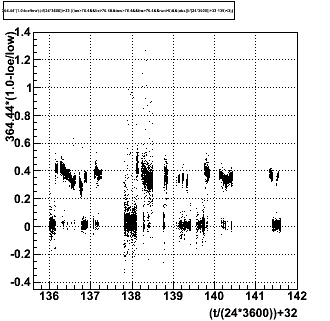
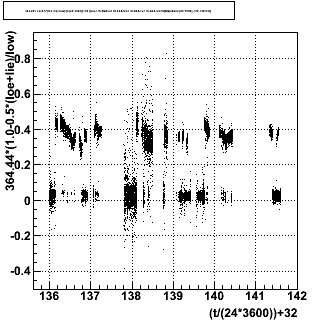
It is not simple to just impose a cut of 0.2 MOhm missing resistance as a time when the partial short is there (and such a cut was used in the automated tracking of this partial short in previous years) because the noise drives some points in this data well above and below such a cut. Unfortunately, unless I find any other ideas, I will likely have to handle these noisy periods in a non-automated way. For other times, OFCE seems to be a reasonable reference.
For Question 4, some consideration should be given to the fact that the shorts are only seen when the channels are noisy, and a partial short is seen when only a partial short exists in another channel (OFCW), and a full short is seen when only a full short exists in another channel. This casts some significant doubt in my mind that these shorts in the IFCW are real, but I decided to look into the slow controls archive (SCA) for more definitive answers. The currents recorded in SCA reveal nothing different from the currents I discussed above, so I will not discuss them further. But the voltages recorded on rings 181 and 182 revealed some interesting information!
First, here are those voltages versus day number in the same arrangement of field cages as mentioned before:

First, the gap is just some data I didn't transfer from the slow controls machine (it's not really missing). The blue is the voltage on ring 181, and the red is on ring 182. Everything looks roughly reasonable (the outer field cage is meant to have more resistance than the inner field cage between ring 182 and ground [see here]) except that the two voltages go to a common value of about -40 V, right when the full resistor short appears on the OFCW! And the resistance between these two rings should be somewhere in the 1.82-1.87 MOhm ballpark (the web page is a little contradictory on the matter), which is a better match for the missing resistance I found for the full short than a standard 2 MOhm resistor.
These resistors are outside the TPC, and can be examined and perhaps fixed (perhaps this could even have been done during the Run if we had noticed this earlier). However, it is also worth noting that the resistance between rings 181 and 182 is comprised of a fixed resistor and a potentiometer, and both would have to be shorted out simultaneously. To me, this points towards a short somewhere else between these two rings (inside the TPC? inside the Keithley?) rather than inside the resistors.
There is still something unexplained: why would the voltages jump to -40V? The current only goes up by about 0.5%, so the voltage over the 440 kOhm resistor should only go up by about 0.5%. Instead we see it go from about -33.3 V to -40 V. I have no explanation for this.
Now, do the voltages show the shorting in the IFCW? The following 4 sets of plot quadruplets are zooms of the voltages on rings 181 and 182 during the two most notable noisy periods. The first pair are for the noisy period around day 138:
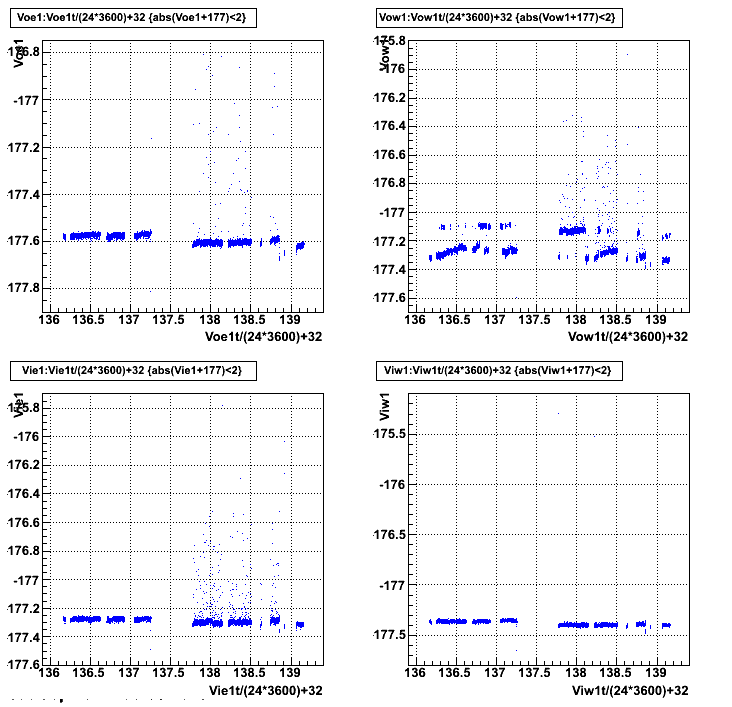
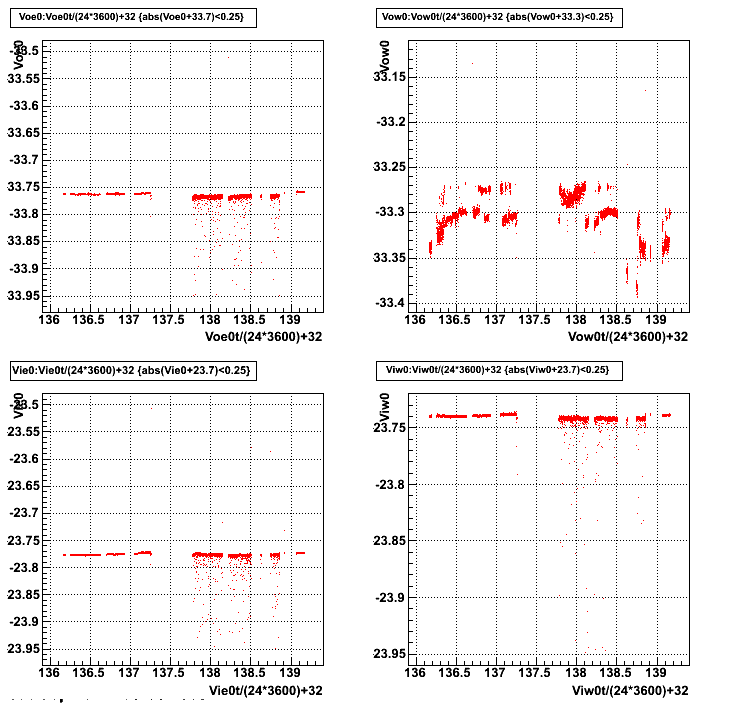
The second pair are for the period around days 164-166:
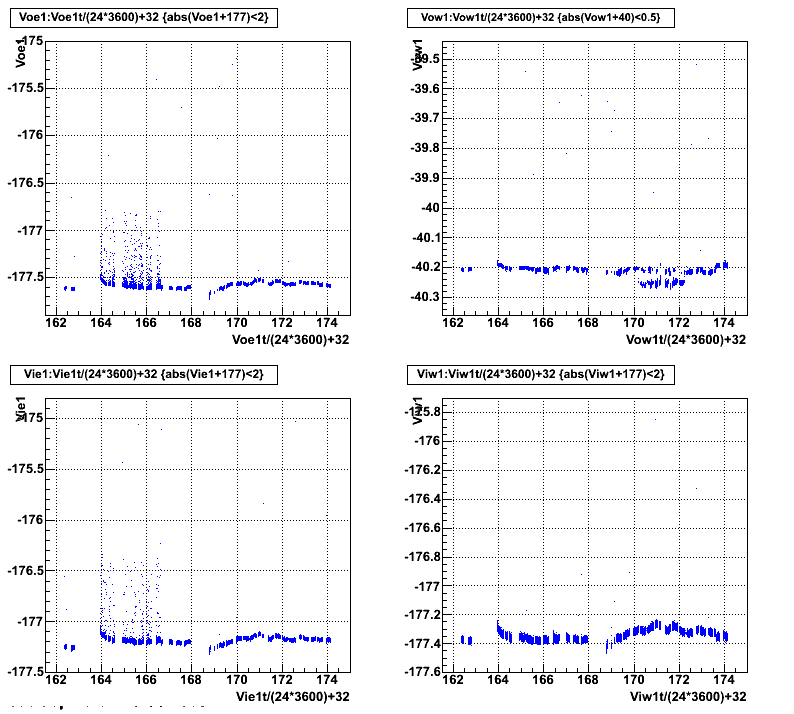
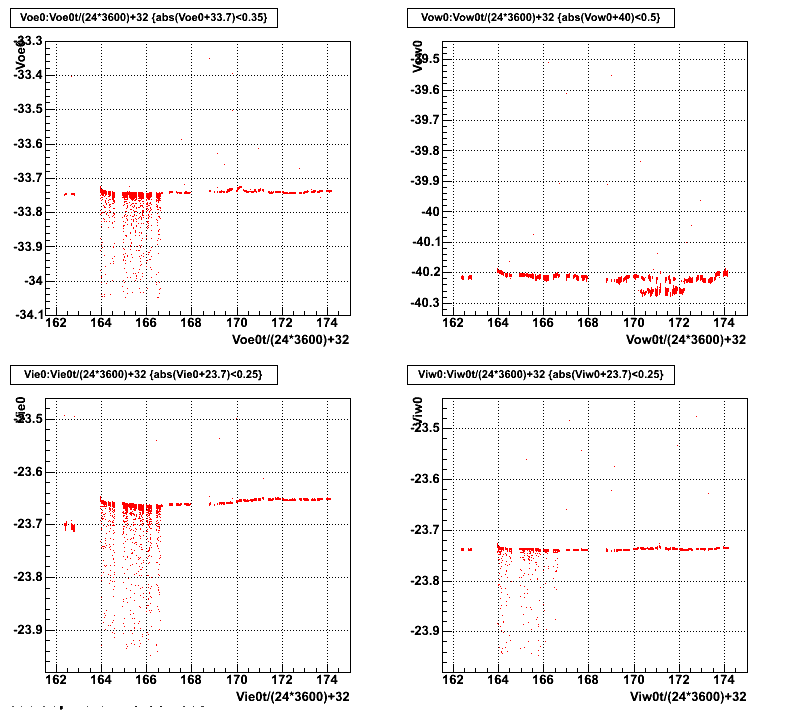
(Please open the images in a new tab or window for larger versions.)
If the short in the IFCW were real, it should see a voltage change comparable to the current changes (using Ohm's Law, V=IR). That means about 0.1% increase during the partial short, and about 0.5% during the full short. Those correspond to about 0.18 and 0.02 V changes for rings 181 and 182 respectively on day 138, and 0.90 and 0.11 V for those rings on days 164-166. These shifts are not seen! I believe this conclusively rules out the existence of any shorts in the IFCW, answering Question 4. I can only guess that the current for the OFCW was sometimes being read in as the current on the IFCW during these noisy periods. I really do not know what the noise means - perhaps it is a matter of wrong channel readings? Can anyone else think of a good test?
There are a few other observations which may be worth noting from the voltages:
- Noise is seen in most (though maybe not all) voltage readings at the same time as the noise in the current readings. This is at least the case for the voltages on the east side, so they are not useful as a reference to automatically detect shorts.
- At least on days 136-139, the voltage readings for OFCW are nowhere near as stable (even when the partial short is not there) as for the other field cages. Could this tell us anything further about the partial short in the OFCW? I haven't figured anything out yet.
That's all for now.
-Gene
- genevb's blog
- Login or register to post comments
